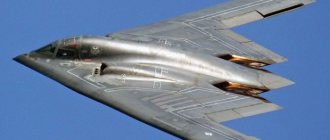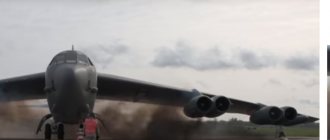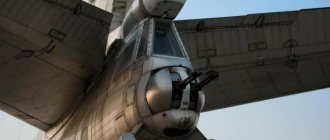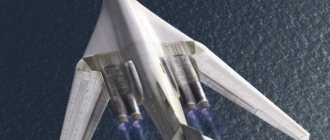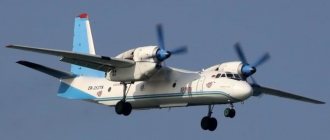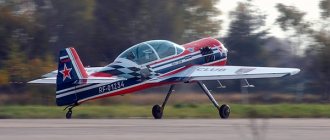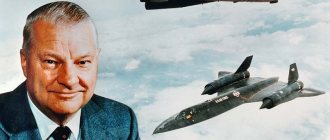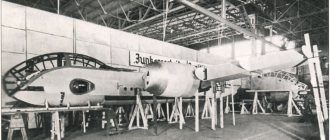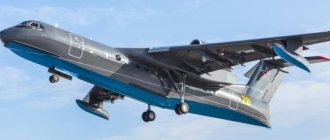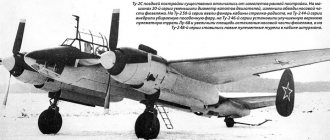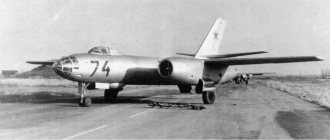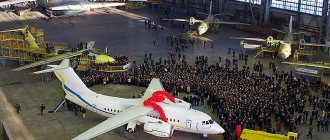Our story is about the famous military aircraft Tu-22 (according to NATO codification, the very first aircraft is Blinder, the latest modification is Backfire), the first flight of which took place sixty years ago. It went through several serious modifications, changing its appearance beyond recognition. There is little in the new M3 that resembles the very first aircraft of the Tu-22 family, which took to the skies in 1958.
Bomber Tu-22 PD - exhibit of the museum in Engels
| Type | Strategic bomber Tu 22 - long-range aircraft |
| Developer | OKB im. A.N.Tupoleva |
| Chief designers | S.M.Eger (Tu-22), D.S.Markov (Tu-22M) |
| First flight | 1958 (Tu-22), 1969 (Tu-22M) |
| Start of operation | 1962 (Tu-22), 1974 (Tu-22M) |
| Assembly location | Kazan Aircraft Plant |
| Latest modification | Tu-22M3M |
Tu-22 design - performance characteristics of modifications
It is most convenient to consider the design features of the bomber by comparing the Tu-22 and Tu-22M. Despite almost the same markings, these are two completely different aircraft. It is not without reason that there is a legend that Andrei Tupolev obtained funds for the development of the “M” option from the CPSU Central Committee with enormous difficulties.
Khrushchev abandoned the development of bomber aircraft in favor of missile weapons. The designers had to resort to a trick and argue that an urgent modernization of the first version of the aircraft was needed.
| Structural element | Tu-22 | Tu-22M |
| Fuselage | Semi-monocoque round section. Divided into five compartments. F1 - between the front fairing and frame No. 1. The radar units are installed at the top, and the antenna at the bottom. F2 - sealed compartment between frames No. 1-13. Here is the cockpit and landing hatches combined with ejection seats. F3 - compartment of fuel tanks No. 1 and No. 2, equipment for aerial photography, radio communication units and technological equipment. At the top right of the compartment is a rescue boat. F4 - between frames 34-60 there is a center section, third and fourth fuel tanks and a cargo compartment. F5 - fuel tanks 5-7 occupy the space between frames 61 and 85. In addition, the compartment contains a control system, a braking parachute, a ventral landing gear support and a firing cabin. An all-moving stabilizer is installed on the sides of the compartment, and on top are the engine nacelles and the keel of the aircraft. | The fuselage cross-section is rectangular. The corners are rounded, except for the front of the cabin. F1 - front fairing (up to the first frame). F2 - in the pressurized cabin (between frames 1-13) there is a cabin for four crew members and aircraft equipment. Hatch covers open upwards. Type of seats - KT-1M. From below, access to the aggregate compartment is provided through three pressurized hatches. F3 - leaky compartment between frames 14 and 33. There is a cargo compartment, tanks No. 1 and 2, a rescue boat LAS-5M, containers with technical equipment and a niche for the front landing gear. F4 - the wing center section is connected to the fuselage (between frames 33 and 60). — F5 — in the tail section between frames 60 and 82 there are mounts for the keel and stabilizer. The middle and tail of the fuselage are made in the form of a single technological compartment. Fuselage material – aluminum alloys D16 and V95 |
| Wing | The constant sweep wing of the Tu-22 consists of two spars, with caissons inside. The sweep angle along the quarter chord line is 52°. Aerodynamic ridges and anti-flutter loads are mounted on the wing. Mechanization - flaps (outer and inner sections) with a deflection angle of 35°. Since 1965, the internal section has been converted into flaperons with servo trimmers | The variable sweep wing consists of three parts:
The SCHK and center section together form the middle part of the wing. The wing structure is caisson. Sweep angle:
At subsonic speeds, the PCHK is in a position of 30°, at supersonic speeds - up to 65°. Instead of ailerons, spoilers are used as mechanization in modifications above M2 |
| Plumage | The tail mechanism includes:
| A swept-back (59° along the leading edge) coffered stabilizer is attached to the fuselage supports on both sides. The leading half, along which angular movements are measured, is the right side of the stabilizer. To give stability to the vehicle at supersonic speeds, a keel with a rudder is installed. In the stern of the keel are the fairings of the television sight camera and radar antenna, and the aft gun mount GSh-23M. The “zero” position of the rudder of the Tu-22M is shifted by 2-3 degrees to the left. This is done in order to compensate for the torque of the engines |
Control system | The aircraft control is electro-hydraulic type. Several hydraulic boosters and drive systems operate:
Vibration damping is carried out using dampers DT105A, D-2K-115 and DST. | The electrohydromechanical control system has four channels:
The roll channel is equipped with a four-channel EMDS. Its steering actuators are responsible for controlling the hydraulic drives of the spoilers. If there is no pressure in the hydraulic system (while parked), the stabilizer goes up |
| Landing gear and drogue parachute | The Tu-22 is equipped with a three-wheel landing gear. The front pillar cleaning scheme is backwards along the flow. The double-leaf niche is located in a compartment inside the fuselage. Wheels - non-braking K2-100u. The two main supports are equipped with K76/4u brake wheels. The wheels are removed by turning the carts over. The landing gear retracts into the wing nacelles | The front strut of the three-legged chassis is equipped with two K2-100u tubeless wheels. The number of KT-156 brake wheels in two rear struts is 6 pcs. The wheel cleaning scheme is similar to the Tu-22. Type of parachute braking system - PTK-45. The container for refilling the parachute is located in the compartment between the engines. Control of the lock release and parachute release system - pneumatic |
| Power point | The power plant includes two single-circuit RD-7M2 engines with afterburners. Traction:
Until 1965, the power plant included VD-7M engines | Two three-shaft single-circuit turbojet engines with an adjustable nozzle and an NK-25 afterburner are installed. Traction:
Specific fuel consumption - 0.76 kg/kgf. Oil consumption - 29 liters per engine |
| Hydraulic system | Two parallel hydraulic systems are the main ones, the third is an emergency one. Both have a variable displacement pump NP-48. The working pressure of hydraulic systems is 210 kg/cm2. The first system is responsible for the operation of the landing gear, the movement of the bomb bay flaps, charging the emergency wheel brakes, and activating the ailerons. The second system serves emergency landing gear release, emergency closing of the bomb bay flaps, and operation of the aileron damper. To operate the emergency system, an ATN-15 pump is installed. Oil type in systems - AMG-10 | Number of working hydraulic systems - 3. Discharge pressure - 210 kgf/cm². working fluid - aviation oil AMG-10. The systems operate in parallel, serving:
|
| Fuel system | The fuel system includes 32 rubber tanks located in the fuselage and wing caissons. For in-flight refueling, a hose-cone system is used. For the first time in the USSR, the Tu-22 used a centralized pressure refueling system. If there is a need to urgently reduce the aircraft's flight weight, up to 28 tons of kerosene can be drained in 15 minutes through drain valves located under the wings and tail | The Tu-22M is equipped with nine groups of fuel tanks with a total capacity of 67,700 liters:
Filling system - necks at the bottom of the fuselage, speed - up to 2000 l/min. The total aircraft refueling time is 35 minutes. It is possible to refuel pistols through the upper necks. Control of refueling and fuel consumption is provided by automatic systems SUIT-4-5, RTS-300B-50 and backup SIT2-1. Fuel is pumped inside the tanks by twenty centrifugal pumps such as ESP (ETSNG). Emergency fuel drainage in flight is provided (except for afterburner mode) |
NK-25 double-circuit engine with afterburner
Specifications
The bomber's design is an all-metal cantilever monoplane. The wing arrangement is medium, variable, swept. The tail unit is single-finned. The landing gear is retractable, tricycle. The technical characteristics of the cabin of the TU-22M3 are noteworthy. It can accommodate up to 4 people. In this case, the crew is placed in pairs: in front - two pilots, in the back - a navigator and a navigator.
The fuselage is also an all-metal structure. The frame is reinforced with longitudinal beams. The wings are coffered, two-spar, consisting of a center section, rotary units and a center section. All parts are inseparably connected to each other. Caissons are used as fuel tanks. Fast maneuverability is achieved thanks to the flaps on the consoles and three sections of the turning unit. The vertical tail is represented by the rudder and keel. The unique propulsion characteristics of the TU-22M3 aircraft allow it to achieve thrust in afterburner mode of up to 20 thousand kgf. In this case, the maximum speed is 2300 km/h, in cruising mode – 930 km/h.
Tu-22 modifications
| Tu-22 modifications | Distinctive features |
| Tu-22R/RD | A reconnaissance aircraft, in the cargo compartment of which photographic equipment was installed, a special automatic reflector reset machine APP-22, radio reconnaissance complexes "Romb-4A" and "Rose". The RD type aircraft could refuel in the air |
| Tu-22RK/RDK/RM | Reconnaissance version with an additional “Cube” equipment complex. Since 1980, a variant of the reconnaissance aircraft, the Tu-22RM, has been flying. |
| Tu-22RDM | In the RDM version, the reconnaissance aircraft was equipped with a complex of radio reconnaissance equipment "Tangazh" and infrared tracking equipment "Autumn". In addition, the avionics set included the M-202 “Ramprod” side tracking station and the “Siren” radio jamming station. |
| Tu-22P/PD/KP/KPD | Jammer. To complete the task, an electronic warfare container and APP-22 assault rifles were placed in the cargo compartment. The SPS-44, SPS-55, SPS-4M, SPS-5M, SPS-30-70, SPS-5M stations were placed in various improved versions of the aircraft. If the aircraft was equipped with a refueling boom, the letter “D” was added to the modification. Since 1968, the KP/KPD variant has flown |
| Tu-22K/KD | A missile carrier with one X-22 missile on board. Used as a bomber if necessary |
| Tu-22U/UD | Training modification of the aircraft. Despite the presence of a refueling boom, this aircraft was not refueled in the air. |
Tu-22M modifications
| Tu-22M modifications | Distinctive features |
| Tu-22M1 | Tu-22M1 began to be developed in 1970. The weight of the airframe has been reduced by 3 tons. The airframe shape and air intakes have been completely redesigned. The engines were located in nacelles on both sides of the fuselage. The aircraft was equipped with a variable sweep wing with a completely new geometry. M1 was the first modification to which the ABSU-145 control system with a fly-by-wire roll channel was installed. The main weapon - the X22 missile - has been modified. Engine - NK-144. The number of aircraft built was 5. They were used in tests to fine-tune systems and structural components. Not mass-produced |
| Tu-22M2 | It was planned to build a modification of the M3 with an NK-23 power plant. But the aircraft went into production with NK-144-2 engines (afterburning thrust 20,000 daN). The aircraft was equipped with a structured control system:
Adopted into service in the summer of 1976. It was serially built until 1983 (211 units). The disadvantages of the modification are the inconsistency of the on-board equipment systems. Modifications to production aircraft were carried out directly in military garrisons |
| Tu-22M3 | A number of significant changes were made to the M3 modification, which was built since 1974:
The air intakes were positioned similarly to the design of the MiG-25 - at an angle to the fuselage. The aircraft is equipped with a new power supply system. The design of the fuel refueling rod has been changed. Serially produced until 1993 |
| Tu-22M3R | Reconnaissance version of the Tu-22M3. The main tasks are target designation and jamming of enemy air defense systems. Produced since 1985. The total number of aircraft built and converted according to the project is 12 units |
| Tu-22M4 | Since 1984, an option with the installation of NK-32 engines has been developed. The avionics (new Obzor radar) and airborne weapons (X-32 and X-15 missiles, UPAB-1500) were re-equipped. In 1990, work on fine-tuning the modification was stopped |
| Tu-22M3M | The latest current modification of the Tu-22M. By 2020, the team of the Kazan Aviation Enterprise must modernize its fleet of 30 aircraft. The aircraft is modified to carry the X-32 air-to-surface missile with a homing head protected from external interference. Changes to the systems and components of the M4 project will undergo minimal changes:
|
The newest modification of the famous bomber - Tu-22M3M
Arsenal and defense
Today, one of the most terrifying and powerful means of air attack is the TU-22M3 bomber. The characteristics of the aircraft's strike section are proof of this. The supersonic aircraft is armed with X-22 type guided missiles. In addition, the bomber has a special compartment for combat equipment of paramilitary units. The intra-fuselage installation and external ejection consoles have the ability to mount up to 10 X-15 missiles. The cargo compartment has special beams for hanging aircraft bombs and mines up to 3000 kg. It is worth noting that the maximum load that the aircraft can experience is about 24 tons.
To protect against enemy attack, the missile carrier is equipped with a GSh-23 cannon system with a built-in radar and computing unit. The Ural-M complex is designed to resist interference and detection of the TU-22M3 aircraft.
Combat use of Tu-22 and Tu-22M
The main purpose of the Tu-22 and Tu-22M long-range bombers is as a deterrent in the nuclear arms race between opposing camps. This explains the unprecedented number of modifications for a military aircraft. The machine was continuously improved and was very often used as a means of maintaining shock forces.
See also the article TU-160 bombers and their technical characteristics
| 1984-1989 Afghanistan | Like many other types of Soviet military equipment, the “carcasses” received a baptism of fire in Afghanistan. In 1984, six Tu-22M2 aircraft of the 1225th Heavy Bomber Aviation Regiment were transferred there. Nine-ton aerial bombs were used as the main weapon when processing the positions of the Afghan Mujahideen. In 1988, similar tasks were performed by the Tu-22M3. The ammunition included bombs weighing 3 tons. The planes took off from the Mary airfield in the USSR |
| 1992 Tajikistan | In the early nineties, the flight missions of Russian pilots shifted somewhat to the north - to the Tajik-Afghan border. Tu-22M3 vehicles of the 840th Heavy Bomber Aviation Regiment operated against the Tajik opposition |
| 1994-2000 Chechen Republic | Since 1994, Tu-22s have been used to perform various combat and support missions in the first and second Chechen wars. The main type of weapon is illumination aerial bombs to ensure the release of adjustable KAB-1500L aerial bombs from Su-34 bombers |
| 2008 South Ossetia | A Tu-22M3 squadron took part in the conflict. The main tasks are to carry out targeted strikes against clusters of gangs in the Kodori Gorge. During the fighting, a Tu-22M3 of the 52nd TBAP (Shaikovka) was shot down |
| 2015-2017 Syria | Since the fall of 2020, 14 Tu-22M3 aircraft have been based at the Khmeimim air force base of the Russian Aerospace Forces. The main tasks of heavy bombers are to drop weapons on clusters of Islamists |
Tu-22M3 aircraft fleet at Khmeimim airbase in Syria
Kuzkina's mother - 3: Kazan aircraft plant will give the Tu-22M3 a “second wind”
Home / Mechanical engineering
9.05.2018
The Tu-22M3M will be equipped with in-flight refueling equipment, which the Americans demanded to be removed from long-range aircraft when signing START-2.
The recently announced modernization of the Tu-22M3 bomber may have a greater effect on the military and KAZ than even resuscitating the construction of the White Swan. The advantage of the new “troika” is that it seems to already exist, while the Tu-160M2 remains to be seen whether it will exist. Overseas partners will be impressed by the fact that the Tu-22M3M version, according to BUSINESS Online, will receive equipment that potentially makes the car another “long arm” of Russia.
At the Kazan Aviation Plant named after. Gorbunov - a branch of PJSC Tupolev (KAZ) will soon begin preparing the first missile carrier-bomber Tu-22M3M for its first flight Photo: ©Sergey Mamontov, RIA Novosti
“...AND A VERY BEAUTIFUL PLANE”
At the Kazan Aviation Plant named after. Gorbunov - a branch of Tupolev PJSC (KAZ) is preparing a new Tu-22M3M missile carrier-bomber for its first flight, the company reported to BUSINESS Online. This is a radical modernization of the famous Tu-22M3, of which as many as 268 were produced in Kazan. It was previously reported that this will, in fact, not be a modernized aircraft, but a completely different aircraft: with the latest avionics, engines and weapons. But behind the enumeration of all kinds of improvements, the most important aspect of modernization was “lost.” According to BUSINESS Online sources in the aviation industry, in-flight refueling equipment, which was once removed from the Tu-22M line of vehicles under American pressure, will be returned to the missile carriers.
To understand the issue, a little background.
Work on the Tu-22M began in 1965 and was declared as a deep modernization of the Tu-22. But during the development of the project, they only had a tactical purpose in common. The characteristics of the new missile-carrying bomber were tailored to solve two main tasks: striking strategic targets within the continent and defeating aircraft carrier strike groups and formations. A resolution of the USSR Council of Ministers of November 1967 obligated the design of a long-range launch vehicle for the X-22 type rocket. The maximum speed was stipulated to be 2300–2500 km/h, the subsonic flight range was 7000 km/h, and the take-off and run length should not exceed 1600 meters.
The test results in 1969 indicated the need for further modernization: the Tu-22M0 showed a subsonic flight range of 4140 km, a maximum speed of 1530 km/h and a take-off run of 2600 m, which, of course, could not satisfy either the Air Force or the Design Bureau. In December 1969, a decision was made to modernize the Tu-22M0 into the Tu-22M1. By 1973, 9 aircraft were built in Kazan, but they never entered combat units - the main characteristics turned out to be lower than required. They decided to build a large series of further development of the theme - Tu-22M2. The lead “two” took off on May 7, 1973, and tests and developments were carried out until 1975. Alas, compared to the “unit”, the flight characteristics have changed little. Nevertheless, in August 1976, the aircraft was adopted by Long-Range Aviation and Navy Aviation. In total, 211 Tu-22M2 were built in Kazan before the end of serial production in 1983.
But in order to ensure the parameters set back in 1967, it was necessary to continue modernization. It led to the creation of the Tu-22M3. Its first flight took place on June 20, 1977, and in 1978 the Troika was put into mass production. In terms of flight and tactical characteristics, the Tu-22M3 is significantly superior to the Tu-22M2: maximum speed - 2000 km/h, ceiling - 13.3 thousand m, range - 6800 km, combat load - up to 24 tons, total combat effectiveness compared to its predecessor increased by 2.2 times. But due to many modifications, the vehicle was officially put into service only in March 1989. A total of 268 of these aircraft were built in Kazan. Production stopped in 1993 (the same time as the Tu-160), presumably by agreement with the Americans. It is believed that today there are 62 Tu-22M3s on the wing.
Let us note that the crew liked the plane. Honored Test Pilot of Russia Mikhail Kovbasenko , who during the formative years of the “troika” was the chief pilot of KAZ, told the BUSINESS Online correspondent: “A real soldier’s machine. She is easy to manage, forgives a lot - even if she is driven roughly, she will not be offended. Despite the fact that this is a large and heavy plane, it was possible to spin a barrel on it... And a very beautiful plane.”
An interesting detail: in the technical manuals for the aircraft, the section describing the refueling system was filled with ink, the image of the boom was retouched even in old photographs of the Tu-22M Photo: © Ministry of Defense of the Russian Federation, RIA Novosti
SCARECROW FOR THE PEOPLE
Military equipment is always not just a commodity, but an object of political bargaining, a tool for all kinds of manipulation, and even more so heavy missile-carrying bombers. Since the 90s, Russia has been intimidating with the possibility of supplying the Tu-22M for export, although with a reservation: in a variant that excludes the use of nuclear weapons. It was reported that in July 1992, negotiations were held on the sale of 12 cars to Iran and that an agreement was even concluded... In 2001, at the Bangalore Air Show, the intention to lease four Tu-22M3 to India was announced, and in 2004, agreements were reached ( this time - about the sale) was reported by the then Russian Defense Minister Sergei Ivanov . In 2005, the media discussed the possibility of supplying a batch of Tu-22M3 to China... One of the managers of the Kazan branch of Tupolev, Lev Nedzelsky , told a BUSINESS Online correspondent that, apparently, for political reasons, the deal to sell the Tu-22M3 to Libya did not take place: “ Although we were ready to sell, and they were ready to buy.”
And at the dawn of the Tu-22M, in the early to mid-70s, information about the appearance in the USSR of a new long-range missile-carrying bomber extremely excited NATO, whose analysts attributed the qualities of an intercontinental carrier to the aircraft. As a result, the Tu-22M2 became a stumbling block in the strategic arms reduction negotiations (SALT-2).
The intensity of the political and technical disputes surrounding the aircraft is well described in a series of articles in M-Hobby magazine. It turns out that on the most pressing issue of the Tu-22M2's range, Western intelligence communities were divided. US military intelligence believed that the aircraft's flight range without refueling was 10,450 km, increasing to 14,350 km with one refueling. The CIA soberly cited figures that were a third more modest. “The Tu-22M became a means of propaganda, appearing as a real scarecrow for the average person,” write the magazine’s authors. In the publication of the American defense department International Defense Review in May 1975, an article appeared entitled “Backfire (Backfire - this is how the Tu-22M is called in NATO - author's note ) - the Soviet analogue of the American B-1." The imagination of readers was excited by information that the Tu-22M2 is a strategic aircraft capable of delivering a 10-ton combat load over a distance of 12 thousand km, and with refueling - 17 thousand.
According to legend, on the night of May 14, 1976, the serial Tu-22M2 performed a test flight at maximum range with one aerial refueling. The aircraft's flight range was about 7 thousand kilometers. The tests were detected by American satellites, and the next day the flight map was laid out at negotiations in Geneva. Despite all the efforts of Foreign Minister Andrei Gromyko , the Americans insisted on including the Tu-22M2 in the list of strategic forces of the USSR.
As a result, at the negotiations it was decided that the USSR would limit the maximum flight range of the Tu-22M, depriving it of intercontinental characteristics, and dismantle the air refueling equipment. The Americans also achieved a limit on the production of Tu-22M - no more than 30 cars per year. In addition, the Soviet Union pledged not to permanently station these aircraft in the Arctic regions - dangerously close to the United States.
In 1979, refueling booms began to be removed from combat vehicles, and they were no longer installed on new aircraft. An interesting detail: in the technical manuals for aircraft, the section describing the refueling system was “removed” and filled with ink. It got to the point of insanity: the image of the boom was retouched even in old photographs of the Tu-22M. Perhaps, with such ostentatious zeal they wanted to hide a “small” trick: the modification did not affect other components of the fuel system, except for the rod - the refueling system units hidden inside remained in place. At the same time, the removed booms were not taken away from the aircraft parking lots. New machines at the factory continued to be equipped with all the necessary components, including the included boom, which, if necessary, could be installed in the field. The Tu-22M3 had an extended nose fuselage, to which a modified fuel refueling rod was “attached”. But, most likely, the Americans knew about it, and if not, they found out in the 90s. After the collapse of the USSR, the 60 Tu-22M remaining in Ukraine (17 Tu-22M2 and 43 Tu-22M3) were destroyed under a program funded by the US Congress. Of course, the Americans studied the planes thoroughly, by the way, just like the Tu-160, one of which was transported overseas.
"THE MOST IMPORTANT JOB"
After the “troika,” modifications of the Tu-22M4 and Tu-22M5 were supposed to appear, but perestroika intervened. “We had very large developments, which, however, have not gone anywhere, but we will implement them not as a whole, but in parts,” Georgy Samerkhanov, the then head of the design bureau of the Kazan branch of Tupolev, told the author of this article in the early 2000s . The new vehicles were seen as a deep modernization of the Troika - with new avionics, sighting systems, engines (the same as on the Tu-160), weapons, and a modified airframe.
But quite a lot of time passed before a decision was made. Only at the beginning of 2012 did information appear that it was planned to modernize 30 Tu-22M3 by 2020. It was said that the Tu-22M3M would differ from the Tu-22M3 in the same way as the latter differs from its predecessor, the Tu-22. Essentially, these are different aircraft. Media sources in the defense industry painted a fantastic picture of the prospects for pilots retraining on the Tu-22M3M: they will need to master new systems for weapon control, navigation, and monitoring the situation around the aircraft; all information will be displayed on electronic displays, the pilot will simply select the mode, target and launch, as in computer games.”
Deep modernization started in April 2016, the KAZ newspaper “Forward” reported this, indicating that this is “the most important work” of the year. Presumably, a contract was then signed to modernize four vehicles. In November 2017, a TASS source in the military-industrial complex spoke about the completion of the development of documentation, noting that the timing of modernization and the number of updated aircraft depend on “the capabilities of the plant, on how the work on the first aircraft goes.”
Interestingly, the modernization of the Tu-22M3 was influenced by the war in Syria. Let us remind you that on November 17, 2020, 12 Tu-22M3 (together with Tu-95MS and Tu-160) launched their first strike against Daesh (the Arabic name for the ISIS group banned in the Russian Federation - editor's note ). While the 95th and 160th operated cruise missiles without entering Syrian airspace, the reinforced Tu-22M3 squadron, operating from the air base in Mozdok, used conventional bombs. The then commander of Long-Range Aviation, Anatoly Zhikharev , said: “During the strikes, Tu-22M3 aircraft covered a distance of 4,510 kilometers in one flight, which lasted 5 hours and 20 minutes.” If you think that throwing “cast iron” in the 21st century is ridiculous, then you can cite the data from one of the articles about the Tu-22M2: with one blow of free-falling bombs, it plowed an area equivalent to 35 football fields, and the capabilities of the sighting equipment made it possible to hit from a 10-kilometer range heights with a single bomb into a separate house. A display of the aircraft was arranged for the leadership of the USSR. At the training ground, mock-ups of a marching column of a tank regiment were built, and one Tu-22M covered the entire column with an area bomb attack. Leonid Brezhnev was so impressed that he awarded the crew commander the Order of the Red Banner.
So, according to experts, the Tu-22M3 worked quite successfully in Syria, however, there were complaints from the Ministry of Defense, which is why they made the final decision on deep modernization. The Ministry of Defense put forward counter proposals from industry, and as a result of this exchange of opinions, the appearance of the aircraft was formed, which is very close to what was published on the Tu-22M3M.
According to experts, the Tu-22M3 worked quite successfully in Syria, however, there were complaints from the Ministry of Defense, which is why they made the final decision on deep modernization Photo: © Ministry of Defense of the Russian Federation, RIA Novosti
IS IT MORE DIFFICULT THAN IN SOVIET TIMES?
“Assembly work and preparations for the first flight, scheduled for the third quarter of 2020, are being completed on the first prototype of the deeply modernized Tu-22M3M,” KAZ reported to BUSINESS Online yesterday. — As part of the deep modernization, new modern digital radio navigation, communications, radio engineering, general aircraft equipment, a weapon control system, and a new information and control complex were developed. A significant part of the new avionics equipment is unified with the Tu-160M. The modernization will expand the combat capabilities of the aircraft, as well as significantly extend the service life of the fleet of long-range missile-carrying bombers.”
“Yes, the deadlines are tight, and the question remains open as to how the new equipment will behave during the testing process, but nevertheless the task has been set, it is interesting and, given the passion with which the pilot production team approaches the process, feasible,” they say in one of the latest issues of the newspaper “Forward”.
We emphasize that the KAZ team played a crucial role in the creation of previous modifications of the Tu-22M. “If the Moscow parent organization was the brains, then we were the brains and hands,” said Samerkhanov. — The work was difficult and time-consuming. The branch provided not only the launch and design and technological support of all modifications of the aircraft in mass production, but also produced a large volume of design documentation, performed a lot of work using the pilot workshop... Such an example. The head design bureau announced a “struggle for weight” program. And immediately proposals began to come from our designers and teams, which yielded good results: more than a hundred of our proposals were implemented, reducing the weight by almost 2.5 tons... All modifications were not easy. Moreover, each was head and shoulders above the previous one. I think that, in the end, the machine turned out to be very successful, and the pilots confirmed this, on par with the world’s best examples of military equipment. And this, of course, is the great merit of the chief designer, Dmitry Sergeevich Markov.”
The birth of the Tu-22M line was not easy. Arskoe cemetery of Kazan, graves of Boris Mashkovtsev and Vladimir Meshcheryakov, who died during the testing of the Tu-22M2 on November 23, 1973 Photo: Ildar Valeev
I must say a few words about Dmitry Markov on the topic “Airplanes and Personality.” One of his Kazan colleagues recalled the work on the “troika” this way: “Then a team consisting of people who perfectly felt each other, honest and direct worked to eliminate the identified shortcomings. The soul of this team was Dmitry Sergeevich. All issues were resolved by him with the utmost efficiency and quality; he was always recklessly absorbed in his work. The always calm, even tone of his work meetings and clear analysis of the situation and issues greatly contributed to making the most correct decisions.” Markov delved into the smallest details of the case. They remember such an incident. They wanted to produce the Tu-22R reconnaissance aircraft not only in Kazan, but also at the Irkutsk aircraft plant. Before the decisive meeting in Irkutsk, Markov walked around the entire production, going so far as to find out which parts were currently being processed on the machines, and then reported in detail on what he saw and concluded: “The launch of the Tu-22R aircraft will not be carried out at the plant.”
By the way, Samerkhanov argued that in Soviet times it was easier to build an airplane - “the entire Soviet Union worked for aviation.”
Will such individuals and such state collectivism appear today?
“Troika” is a real symbol of the Kazan aircraft plant: 268 (!) of these aircraft were produced here Photo: “BUSINESS Online”
“MUST BE USED TO THE FULLEST ELEMENT”
In response to a request from BUSINESS Online, KAZ carefully avoided the topic of returning in-flight refueling. Andrey Frolov, editor-in-chief of the Arms Export magazine , believes, this equipment will definitely be on the Tu-22M3M. “A kind of return to the roots,” he noted in an interview with BUSINESS Online and also added that the new “troika” will have a glass cockpit with multifunction displays instead of analog instruments. But the expert doubted that the latest NK-32-02 engines, the production of which is just starting in Samara, will be installed on the plane: “I don’t think that the NK-32 will be rated “three” - it’s a bit fat, and Samara is unlikely to be able to handle the engines both for Tu-160M2 and Tu-22M3M.”
Will Russia violate international agreements by installing in-flight refueling equipment on the Tu-22M3M? “The START-2 Treaty is not in force now, and we are free to act in relation to the Tu-22M3 as we see fit,” Viktor Murakhovsky, . — The current treaty is START-3. There is nothing said about this. The treaty determines the number of delivery vehicles and the number of nuclear warheads. The scoring system is as follows: one long-range bomber is counted as one carrier and one nuclear warhead.”
The plane is waiting for another interesting innovation. It is not as progressive as the appearance of a glass cockpit or in-flight refueling equipment, but it is effective from the point of view of a kind of air combat ideology and aviation aesthetics. The stern cannon installation will be removed from the Troika. “Today this is archaic,” states Murakhovsky. - Today, close air combat and interception by fighters using small arms and cannon weapons is a retro style (which is like cyberpunk - author's note ). Therefore, of course, it is necessary to remove the gun, but at the same time strengthen the aircraft with a modern electronic suppression complex. Perhaps this will not be the Vitebsk complex specifically, but something adapted for the Tu-22M3: after all, the mass of the gun with ammunition is quite large, so instead of it it is quite possible to make a fairly powerful radio-electronic and optical-electronic suppression station.”
“In theory, this gun shouldn’t have existed at all; it’s completely unnecessary there,” Frolov explained. — But the military insisted in the late 60s. Why? The fact is that the military was tired of problems with the electronic warfare (EW) complex on the Tu-22 and, so that the Tu-22M would not be left without passive protection if this complex did not work, they decided to install a cannon, because it can be used to fire traps. It turned out to be the last means of protecting the aircraft.” The fact is that the remotely controlled (aiming via television or radar channels) aft cannon installation UKU-9A-502M with a 23-mm GSh-23M cannon can conduct both regular automatic fire and shoot anti-infrared (PIKS, equipped with a high-temperature combustible mixture ) and anti-radar (PRL, equipped with dipole reflectors) projectiles. Wouldn't it be easier to perfect the electronic warfare system? “It’s not easier,” Frolov is sure, “because even on the Tu-160 it was a dead weight for a long time. By the way, the same thing happened on the American B-1.”
Returning to in-flight refueling: Frolov doubts that its restoration is appropriate today: “In the current conditions, this is partly pointless work: for one simple reason - we have less than 20 refuelers, while the number of users with a boom is increasing every year. To increase the group of aircraft with a boom when you have less than 20 Il-78 tankers... Yes, they raised a prototype of a new tanker, but Ulyanovsk, at best, will only make three or four vehicles a year. If a big war happens, the strategic missile carriers Tu-95MS and Tu-160 will have priority, so it is not clear what the point is in equipping the Tu-22M3M with refueling. Yes, you can install it everywhere, but recently there was news: naval pilots on the Su-30SM made the first contact, that is, it was only now their turn!.. But yes, it is possible to carry out expensive development work only in order to in the distant future to be able to refuel. This is a question of priorities and efficiency of spending funds.”
Murakhovsky draws attention to something else: “Given the current emphasis on creating weapons systems that provide strategic non-nuclear deterrence, in-flight refueling is a completely reasonable solution: the vehicle is there, a promising high-precision weapon is being created, and if the refueling equipment is returned, the aircraft will turn into a strategic weapon.” radius. In addition to groups that carry out strategic non-nuclear deterrence of conventional means (sea-launched cruise missiles "Caliber" and air-launched Kh-101), it is very useful to have a long-range Tu-22M3 with high-precision weapons, with a range that allows solving strategic problems. The airframe is good, the aircraft performs its tasks normally, especially after being equipped with the SVP-24 (new sighting and navigation system - editor's note ). We must use its capabilities to the fullest."
In a word, following the declared revival of the production of the Tu-160 and the Mi-14 , this will be the third “Kuzka’s mother” for Americans originally from Kazan.
Timur Latypov
Photo on the announcement: ©Ministry of Defense of the Russian Federation, RIA Novosti
Enterprises: KAZ im. S.P. Gorbunova
print version
Tu-22 accidents
Until 1992, more than seventy Tu-22 aircraft and its modifications suffered accidents for reasons not related to combat operations.
21.06.1958
The very first prototype of an experimental aircraft crashed at the airfield in Ramenskoye
During landing, the front landing gear failed. On December 21, 1959, when reaching supersonic speed, the stabilizer was destroyed due to elevator flutter. During the uncontrolled dive, the radio operator managed to eject. The commander and navigator of the crew were killed.
The causes of Tu-22 accidents over the years of operation in combat units and test centers of the USSR Air Force were:
- engine failure;
- flutter when the aircraft reaches supercritical conditions;
- failure of control systems;
- landing gear failure;
- violation by aircraft crews of flight rules and safety regulations.
Tu-22M3 crash during the Zapad-2017 exercises.
Of the 157 Tu-22M aircraft and its modifications built, 22 aircraft crashed for various non-combat reasons. One plane crashed while flying during the fighting in South Ossetia: on August 10, 2008, it was shot down by a salvo of a Georgian Buk-M1 anti-aircraft missile system.
